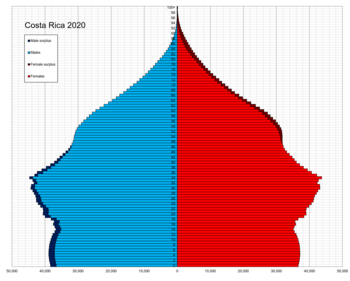
Back Население на Коста Рика Bulgarian Demografía de Costa Rica Spanish Démographie du Costa Rica French 코스타리카의 인구 Korean Kosta Rikos demografija Lithuanian Demografia da Costa Rica Portuguese Costa Ricas demografi Swedish Населення Коста-Рики Ukrainian
| Demographics of Costa Rica | |
|---|---|
 Costa Rica population pyramid in 2020 | |
| Population | 5,153,957[1][2] |
| Birth rate | 10.2 births/1,000 population (2022 est.) |
| Death rate | 5.6 deaths/1,000 population (2022 est.) |
| Fertility rate | 1.29 children per woman (2022 est.) |
| Age structure | |
| 0–14 years | 18.71% |
| 15–64 years | 68.44% |
| 65 and over | 12.85% |
| Nationality | |
| Nationality | Costa Rican |
| Major ethnic | |
| Minor ethnic |
|
| Language | |
| Official | Spanish |
| Spoken | Spanish, English, Mekatelyu, BriBri, Patois |
This is a demographic article about Costa Rica's population, including population density, ethnicity, education level, health of the populace, economic status, religious affiliations, and other aspects of the population.
According to the United Nations, Costa Rica had an estimated population of 5,153,957 people as of 2021. White and Mestizos make up 83.4% of the population, 7% are black people (including mixed race), 2.4% Amerindians, 0.2% Chinese and 7% other/none.[4]
In 2010, just under 3% of the population was of African descent. These are called Afro-Costa Ricans or West Indians and are English-speaking descendants of 19th-century black Jamaican immigrant workers. Another 1% is composed of those of Chinese origin, and less than 1% are West Asian, mainly of Lebanese descent but also Palestinians. The 2011 Census provided the following data: whites and mestizos make up 83.4% of the population, 7% are black people (including mixed race), 2.4% Amerindians, 0.2% Chinese, and 7% other/none.[4]
There is also a community of North American retirees from the United States and Canada, followed by relatively large numbers of European Union expatriates (chiefly Scandinavians and from Germany) come to retire as well, and Australians.[5] Immigration to Costa Rica made up 9% of the population in 2012. This included permanent settlers as well as migrants who were hoping to reach the U.S.[6] In 2015, there were some 420,000 immigrants in Costa Rica[7] and the number of asylum seekers (mainly from Honduras, El Salvador, Guatemala and Nicaragua) rose to more than 110,000.[8] An estimated 10% of the Costa Rican population in 2014 was made up of Nicaraguans.[9]
The indigenous population today numbers about 60,000 (just over 1% of the population), with some Miskito and Garifuna (a population of mixed African and Carib Amerindian descent) living in the coastal regions.
Costa Rica's emigration is the smallest in the Caribbean Basin and is among the smallest in the Americas. By 2015 about just 133,185 (2.77%) of the country's people live in another country as immigrants. The main destination countries are the United States (85,924), Nicaragua (10,772), Panama (7,760), Canada (5,039), Spain (3,339), Mexico (2,464), Germany (1,891), Italy (1,508), Guatemala (1,162) and Venezuela (1,127).[10]
- ^ "World Population Prospects 2022". United Nations Department of Economic and Social Affairs, Population Division. Retrieved July 17, 2022.
- ^ "World Population Prospects 2022: Demographic indicators by region, subregion and country, annually for 1950-2100" (XSLX) ("Total Population, as of 1 July (thousands)"). United Nations Department of Economic and Social Affairs, Population Division. Retrieved July 17, 2022.
- ^ a b c d e "Costa Rica: Población total por autoidentificación étnica-racial, según provincia y sexo. (Spanish)". Instituto Nacional de Estadística y Censos (Costa Rica). Retrieved 2016-11-19.
- ^ a b "Costa Rica es multirracial, último censo lo pone en evidencia".
- ^ "23 Downsides to Living in Portugal". Portugalist. 2019-01-06. Retrieved 2022-06-24.
- ^ "Principal". Inec.go.cr. 27 March 2012. Archived from the original on 27 March 2012. Retrieved 30 August 2017.
- ^ "International Migrants by Country". Pewglobal.org. 10 November 2016. Retrieved 30 August 2017.
- ^ Holpuch, Amanda (26 July 2016). "US partners with Costa Rica to protect Central American refugees". Theguardian.com. Retrieved 30 August 2017.
- ^ Cherry, Andrew; Mary Dillon (2014). International Handbook of Adolescent Pregnancy: Medical, Psychosocial, and Public Health Responses. Springer Science & Business Media. p. 258. ISBN 978-1-4899-8026-7. Retrieved 5 November 2016.
- ^ Costa Rica - Emigrantes totales (in Spanish) Según los últimos datos publicados Costa Rica tiene 133.185 emigrantes, lo que supone un 2,77% de la población de Costa Rica. Si miramos el ranking de emigrantes vemos que tiene un porcentaje de emigrantes medio, ya que está en el puesto 44º de los 195 del ranking de emigrantes.